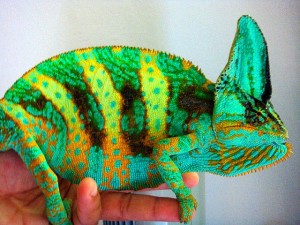Imagine if you changed color based on your emotions? The chameleon does just that! The chameleon is a fascinating animal that shows their emotions through the color of their skin. Many people think that chameleons change their color to match whatever surface they are on, but this is not true. The only reason people think this is because of what they watch on television or cartoons. Chameleons actually change their color based on their emotions. They also change their color to blend in with the environment when they are in the wild to keep predators away. A chameleons color is also based on the temperature and lighting of whatever environment they are in. They can have rapid color changes during social interactions, which involve the means of communication.
Chameleons are cold-blooded animals, so their body temperature depends with the weather or their environment. When they get up in the morning, they usually like to bask in the light, or rest. When they get too warm, they go in the shade to lower their body temperature. Usually, chameleons like to live alone. You could have two pet chameleons, but it is preferred that they live in separate cages so they can each have One eye could be looking up, while the other is looking behind them. The chameleons tongue is very long and is very fast; it is fast enough to catch a fly in the air. Their tongue has a sticky tip on the end to when they catch their prey so it doesn’t fall off.
The Chameleon tends to be a very timid lizard and they would rather not fight. This is the reason why many people like to have them as pets. If you wanted to own a chameleon though, be prepared for a lot of responsibility. Chameleons require very specific care because they need to live in an environment like their original habitat, rain forests. They need the correct heating, lighting, temperature, humidity, environment, and food. They are definitely an animal that you need to commit yourself to. You need to change the different lights every morning and every night because they need exactly 12 hours of day and 12 hours of night, so they can tell the difference between day and night. You have to spray their cage and them at least twice daily to keep proper moisture, but I recommend doing it more. They must have a proper diet including insects and plants, but only certain kinds of plants. If you are a busy person who is not home very much, I would not recommend this animal for you as a pet. If you are home enough and are interested in having a very exotic animal like a chameleon, go for it! I have one of my own who is a veiled and is a girl. As they grow their colors look very beautiful. The chameleon’s vibrant color and calm behavior are what make them a much loved animal and well known around the world.
- How do chameleons change their color?
- How many different types of chameleons are there?
- What are details about the proper care for chameleons?

I have always thought, myself, that chameleons did always change color for there environments to protect themselves from predators and also from prey. I found it very intriguing that they actually change to what mood they have. I decided I should look more into your first question.
Chameleons change color to regulate temperature and to interact with other species. They become dark to absorb heat and pale to reflect the suns rays. This can happen because there outmost lair of there skin is transparent.
http://www.wired.com/2014/04/how-do-chameleons-change-colors/
I found this topic very informing and eye opening. I had never realised that Chameleons do NOT change to every color, or that they change color based on mood. Also, it came as a shock that they do not like to be seen, not even by a camera. One of the weirdest facts I learned was that the Chameleon’s toung can stretch to almost the length of it’s body! In response to one of the above questions, number 2, I found that there are more than 150 species on this website: http://www.encyclopedia.com/topic/chameleon.aspx